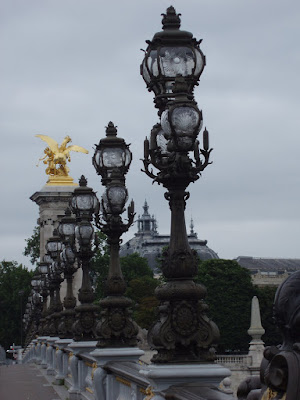Meg and I hopped on the bus after class, having decided to go to the Petit Palais, the Beaux-Arts museum known for its fin-de-siécle collection. The museum was one of two pavilions created for the great fair given in

And a couple of pictures of the bridge itself.


A great statue of Winston Churchill – I think it’s better than the one in

The Petit Palais.

Inside, it’s definitely my favourite thing so far. I planned to buy a book with pictures of everything, should such a thing exist, and to my sorrow it did not. So I have a nice book with pictures of some of the key works, but sadly not everything I really loved. Meg and I both adored the religious art at one end of the big gallery on the first floor. There were three works by which we were most impressed, but we’ll get to that.
The special exhibition at the moment is on Flamenco. It was interesting, though despite an appreciation of dance, being a Spanish art enthusiast I would have loved to see more general Spanish subjects. There were free performances of dance and music in and out of the museum all afternoon.

The building is a great exposition building of the fin-de-siécle, and features ceiling rosettes that were painted by established artists and combine the usual fantastical ceiling stuff with scenes that represent


It makes for an unusual and refreshing atmosphere in the sculpture gallery, particularly, where this sculpture – Woman with Monkey by Camille Alaphilippe – was my favourite.

Speaking of refreshing, the first gallery of paintings was probably my favourite. It was stuffed full of portraiture and different scenes, all freed from the Biedermeyer straitjacket. Alfred Roll chose to depict his subject, genuine master builder Adolphe Alphand who was responsible for the

I could probably post half the art gallery on here, but I’m not going to and nor do I have pictures of everything! The religious art at one end of said gallery was fascinating, both well-executed and really unusual in topic, so Meg and I spent some time there. Subjects included the Good Samaritan inspired by Spanish art, Christ in the valley of tears (seen in the background of the close-up), and this sculpture by Louis Ernest Barrias of “The First Funeral,” the burial of Abel by Adam and Eve.


Eve and Abel are classic, Bernini-perfect figures, while (to evoke a sense of the primeval) Adam is recognisably depicted as an ancient
And one final sculpture – the fall of Icarus by XXXXXX. I was impressed by how the speed of the fall was captured, and struck by how much I liked the sculpture in the Petit Palais.

No comments:
Post a Comment